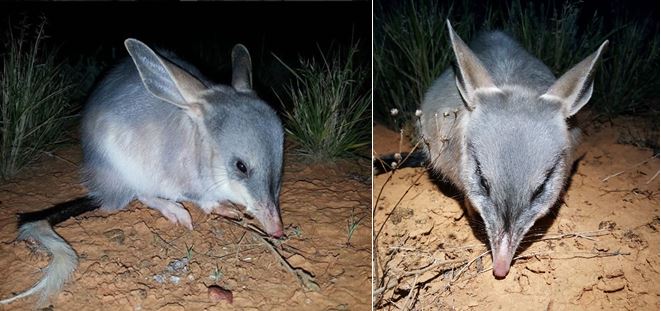Cat exposure makes bilbies smart!
Aly Ross
14 May 2019
Greater-Bilby_Alexandra-Ross-sml2-897x505.jpg?lang=en-AU)
Meet the Australian bilby! These long-eared marsupials are one of the cutest species in the country, and they’re vitally important to arid ecosystems where they’re diggings help to trap resources, turn over soil, and even provide refuge for other species. They’re so important that they’re called “ecosystem engineers”. They’re perfectly designed for what they do, but unfortunately they’re also perfectly designed to become dinner for hungry cats.
 The greater bilby (Macrotis lagotis) is recognisable thanks to the distinctive long ears and pointy nose. Their range has declined by up to 70% since European arrival.
The greater bilby (Macrotis lagotis) is recognisable thanks to the distinctive long ears and pointy nose. Their range has declined by up to 70% since European arrival.
Native species like the bilby often aren’t equipped to handle invasive predators like the feral cat and fox. This is because our country has been isolated for millions of years, and our unique fauna have evolved without foreign predators. This means that they don’t know how to properly protect themselves! We call this ‘prey naiveté’ and it’s one of the leading causes for failed reintroductions and population decline. Cats are ferocious killers and they often kill more than they can eat, creating an even more devastating impact on our native species. They sometimes leave uneaten remains under mounds of sticks and leaves like this one.It’s no surprise that ecologists have been trying to ‘train’ naïve prey to recognise invasive predators and react appropriately to them, but it’s really (really, really, really) difficult to figure out what cue to use and what strategy to teach. For example, is it best to show a bilby a stuffed cat and then chase it into a burrow (thus teaching it to hide when it sees a real cat), or is it better to spray cat urine and then chase the bilby away (thus teaching it to run when it smells a cat)? Evidence shows us that none of these methods are truly effective at improving survival outcomes when the trained animal is released into the wild with real predators. So, what should we do
Cats are ferocious killers and they often kill more than they can eat, creating an even more devastating impact on our native species. They sometimes leave uneaten remains under mounds of sticks and leaves like this one.It’s no surprise that ecologists have been trying to ‘train’ naïve prey to recognise invasive predators and react appropriately to them, but it’s really (really, really, really) difficult to figure out what cue to use and what strategy to teach. For example, is it best to show a bilby a stuffed cat and then chase it into a burrow (thus teaching it to hide when it sees a real cat), or is it better to spray cat urine and then chase the bilby away (thus teaching it to run when it smells a cat)? Evidence shows us that none of these methods are truly effective at improving survival outcomes when the trained animal is released into the wild with real predators. So, what should we do
 Bilby released at Arid Recovery
Bilby released at Arid Recovery
Arid Recovery embarked on an exciting world-first research project to answer just that. If we can’t teach animals the correct anti-predator behaviour… then maybe they can teach themselves! Five cats were released into Red Lake Exclosure (26km2) in 2015, as a method of fast-tracking evolution in the bilby population.
 A map of Arid Recovery showing the different exclosures used in this research project
A map of Arid Recovery showing the different exclosures used in this research project
For two years, the cats were used as a live training method, and in 2017 it was time to discover if the project had been a success.
The first thing we wanted to know was whether bilby behaviour differed between the cat-exposed population and the cat-free population. Had the bilbies in Red Lake learned to behave differently in order to avoid cats? To compare behaviour we caught 16 bilbies from Main Exclosure (the cat-free population) and 10 bilbies from Red Lake (the cat-exposed population) and put each bilby into a pen where we filmed their behaviour for 15 minutes. The cat-exposed bilbies spent less time moving, and more time hiding under the available cover than the cat-free bilbies. So in just two years they’ve learned to go still and hide instead of running around in the open where cats can easily spot them!
 A bilby hiding in a quickly-dug burrow
A bilby hiding in a quickly-dug burrow
The second thing we wanted to know was whether the two years of cat exposure impacted the survival of bilbies when released into a predator-rich area of Arid Recovery. To test this, we released 21 cat-exposed bilbies and 21 cat-free bilbies into Dingo Pen (37km2) which had ten cats. Amazingly, the cat-exposed bilbies had a significantly greater chance of survival than the cat-free bilbies! This means that the two years of cat exposure successfully taught bilbies correct survival strategies for living in an environment with feral cats.
 Cat-exposed bilbies had a greater survival probability than cat-free bilbies over 40 days. (p = 0.042, with 95% confidence intervals).
Cat-exposed bilbies had a greater survival probability than cat-free bilbies over 40 days. (p = 0.042, with 95% confidence intervals).
This is the first time an experiment like this has been done, and the results could impact reintroductions around the world. Tackling prey naiveté is a global issue, and thanks to the ground-breaking research at Arid Recovery, conservation scientists finally have a strategy that could help endangered species survive with invasive predators.
This work was a collaboration between Arid Recovery, the University of New South Wales and the University of California – Los Angeles. To read the full publication, click here.
 Project leader Aly Ross with a bilby
Project leader Aly Ross with a bilby
https://doi.org/10.1111/1365-2664.13406